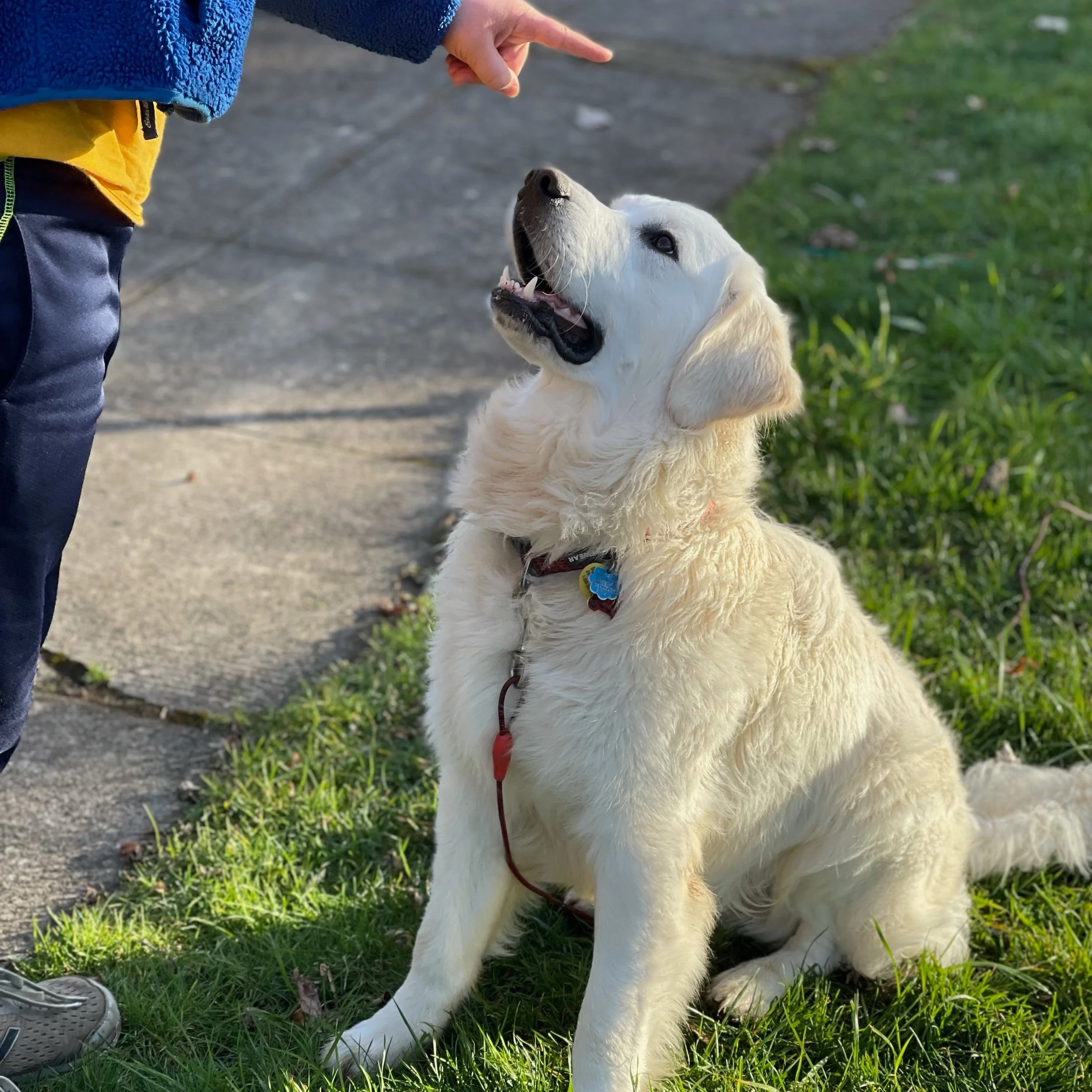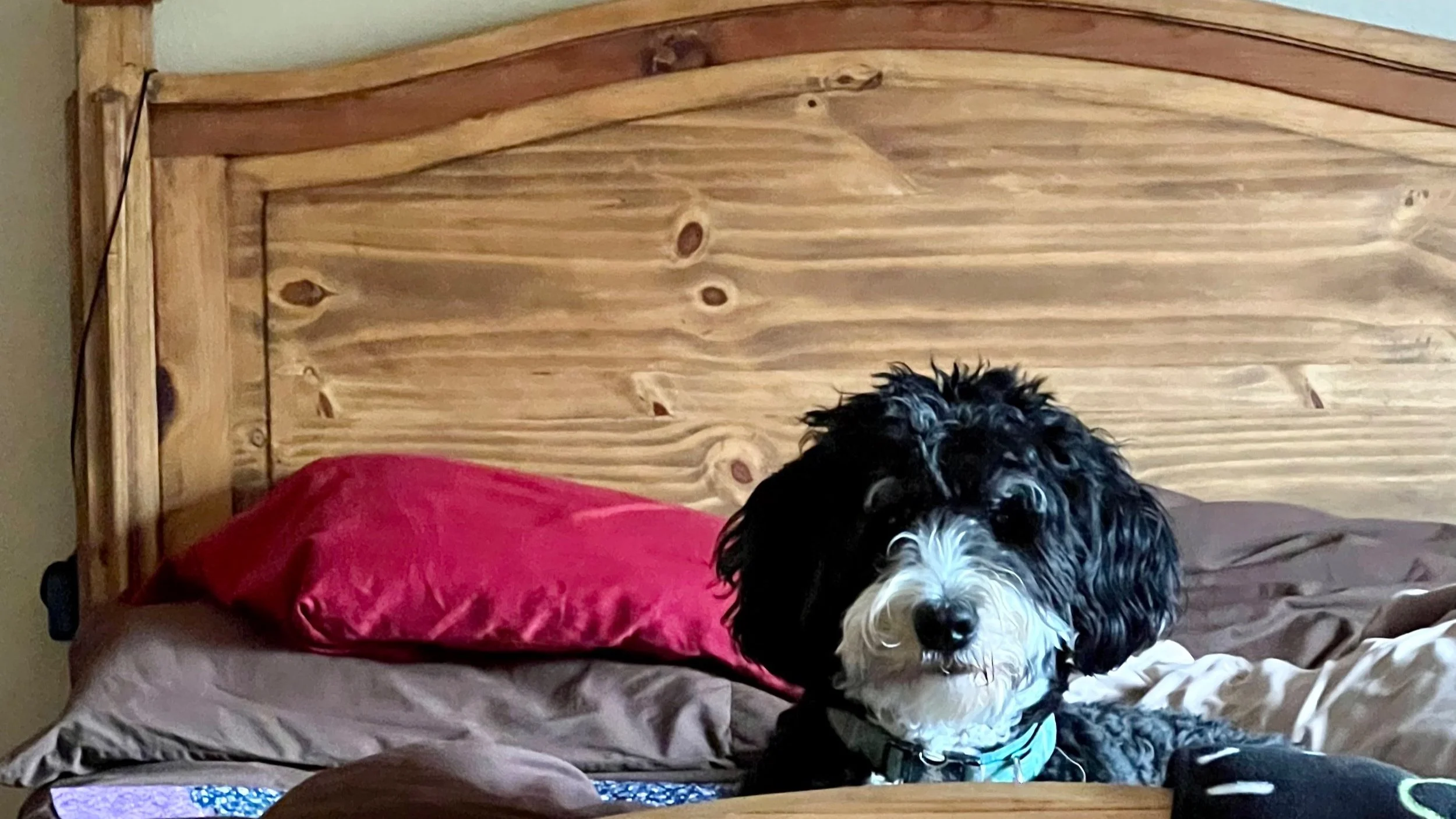How Goldendoodles and Bernedoodles Think
In our journey to better understand our Goldendoodle & Bernedoodle puppies and adults, we recently red How Dogs Think; What the World Looks Like to Them and Why They Act the Way They Do by Stanley Caren. This was an informative and engaging read surrounding the mental hardware and lives of humanity’s best friend. Here are some key takeaways from the book about our Goldendoodles and Bernedoodles here in Oregon.
The most important period in a Goldendoodle & Bernedoodles life is 4-12 weeks.
Goldendoodle puppies taking a break from learning.
While I was aware that this window was highly important for our Bernedoodles and Goldendoodle’s socialization and development, this book made me feel like I still wasn’t doing this period justice.
Coren draws the distinction between critical periods and sensitive periods. He defines critical periods “as a special time in life when a small amount of experience will produce a large effect on later behavior” (148). Critical periods leaves an unalterable impact on behavior, while sensitive periods can still allow for flexibility later on. Coren claims that this socialization period of 4-12 weeks is the closest thing to a critical period in a Bernedoodles or Goldendoodles life. Because of this, it’s vital for a Goldendoodle or Bernedoodle puppy to have adequate interactions with both other dogs and people during this window. It shapes their behaviors and social development in ways that are nearly impossible to undo further down the road.
Since we send our Goldendoodle and Bernedoodle puppies home at 8 weeks old, these puppies spend half of this time with us, and half with their forever homes. We strive to give these Goldendoodles and Bernedoodles as much socialization and exposure as we can. However, this also heightens the tension for their owners between beneficially exposing them to the world around them, and protecting them from particular pathogens until they are fully immunized. Coren’s explanation of this period places a massive importance on being able to creatively find ways to expose your Bernedoodle or Goldendoodle. This is because fully sheltering them during this period has an impact on these puppies that is nearly irreversible.
Poodles and Golden Retrievers are among the easiest dogs to train.
Class in in session for our Golden Retriever Mango. You’re doing great!
In chapter 11, Coren discusses various survey results that focus on the trainability of different dog breeds. He discusses two surveys in particular. One was conducted by Benjamin and Lynette Hart, and the other was conducted ten years later by himself. There were some repeated breeds in the top 20% on both of these surveys; most notably the poodle and the Golden Retriever, which are the two breeds that produce goldendoodles. Poodles rank #4 on Hart’s survey and #2 on Coren’s survey, and Golden Retrievers rank #9 on Hart’s list and # 4 on Coren’s list.
I find this information both informative and helpful for a couple of reasons. First, we’ve heard more and more disparaging comments surrounding the trainability of doodles, and Goldendoodles in particular. To me, these surveys show that:
poodle hybrids have inherited a substantial ability to be trained due to their poodle lineage, and
Goldendoodles are the doodle that is most receptive to training, since Golden Retrievers also ranked near the top of most trainable dog breeds.
With these strong characteristics, the obstinacy of doodles - and goldendoodles in particular - is substantially due to environmental factors as they age. This could potentially be due to missing the socialization window, a general lack of training, or other variables as well. However, Goldendoodles, Bernedoodles, and other Doodles have great pedigree that’s receptive to training.
Puppies can sense heat, but dogs can’t feel heat.
Our Goldendoodles Luca and Honey are enjoying the Central Oregon heat!
I found this really interesting! Coren states that puppies have particular heat sensors in their nose that helps them find their moms. These sensors detect a form of infrared energy, so that they swing their heads back and forth to see their moms heat trail, so that the puppies can then feed or rest(94). Whenever the puppy finds its mom, they will come to rest and stop whimpering. It’s amazing to see this process happening with our Goldendoodle and Bernedoodle litters. The Bernedoodle and Goldendoodle puppies will be surprisingly mobile when they’re trying to find their moms. They are quite good at finding their Goldendoodle or Bernedoodle momma, even through the puppy’s eyes are still shut. Oddly enough, mature dogs don’t seem to have these sensors, so they tend to either disappear or stop working at some point.
Additionally, “with the exception of those heat sensors around the nostrils of puppies, dogs have only cold-sensing temperature receptors” (99). So, unlike people who can both feel heat and coldness, dogs can only feel cold. While dogs can sense warmth - such as resting in a sunlit location - they experience it quite differently than people. For instance, “pressing warm or even moderately hot items against a dog’s skin produces very little response (99). Dog’s main response to heat is comes from their pain receptors, which begin to register the sensation when their tissue is damaged. This makes dog’s highly susceptible to things such as burns, such as running on hot asphalt during the summer. To me, this explains why it seems like our Goldendoodles or Bernedoodles get way to close to a bonfire; it’s because they can’t feel it! So as our dog’s caretakers, we need to be mindful of this, and help protect them from heat.
Our eyesights are better than dogs, but their smell is incredibly better.
Bernedoodle Belle can smell everything you’re cooking, and I mean everything!
I also found it interesting that a human eyesight is typically much better than a dogs. People’s primary sense is sight, so it’s important for us to use it effectively. If you want to have an idea of how the average dog sees the world, try looking through a piece of cheesecloth. Could you imagine having that much of your vision obscured as you eat, bathe, shop, drive, and woodwork? I’m surprised dogs don’t run into things more, although it also explains why some of my canine friends do occasionally ram their heads into a door jam.
Also, while Bernedoodle and Goldendoodles are not technically colorblind, they do primarily see in yellow and blue, and with less intensity. Red are quite difficult for dogs to see too (33).
A dog’s primary sense is their ability to smell; “dogs can identify smells somewhere between 1,000 to 10,000 times better than humans can” (51). They largely interface with their worlds through their sense of smell, which is another reason that the mind of a dog is an enigma. Dogs can also breakdown complex smells into their constituent parts. This means that where a person might smell a cheeseburger, a dog can smell the bun, meat, cheese, tomato, lettuce - and hopefully there’s bacon there too - all seperately and distinctly. Additionally, some dogs have even been able to detect the smell of things like cancer, so take note if your Goldendoodle begins to pay special attention to one of your moles.
There are more differences within breeds and bloodlines than across them.
I wanted to note this last thing, which is that there is more temperament variety within a particular breed, than across breeds. Particular breeds tend to get stereotyped in particular ways regarding things like excitability, aggression, and aloofness. Now while Coren doesn’t reject theses stereotypes, he does state that this should be more contextually understood. This is because there is a wider spectrum within a particular breed surrounding temperament and behavior. Again, this places a massive emphasis to me on the importance of the dog’s environment.
Did they have early diverse exposure and socialization? Were they nurtured into confident puppies and adults? Or were they left alone, and taught that the world is full of danger and scarcity?
As I reflect on this book, it leaves me feeling the weight of our responsibility and call as one of the best Goldendoodle and Bernedoodle breeders. We play such a massive role in whether our Goldendoodles and Bernedoodles flourish or flounder. I’m glad that we take this responsibility seriously, knowing that we are playing a paramount role in our puppies’ formation. We deeply believe we are doing the best we can to help our Bernedoodles and Goldendoodles flourish, and are thankful for books like How Dogs Think as we continually seek education and instruction.
It’s a great book that we heavily recommend for anyone trying to understand the life of a dog more!
Warmly,
Erin and Jay






